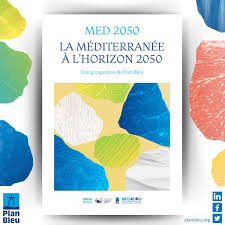
Plan Bleu has released a comprehensive foresight study, the result of years of collaborative work involving numerous experts. This study outlines six possible scenarios for the Mediterranean (as both a sea and a region) by 2050.
The report aims to provide decision-makers and stakeholders with critical insights into the major challenges the region will face in the coming decades. It is unveiled ahead of the United Nations Ocean Conference (UNOC), set to take place in June in Nice, a Mediterranean city, where it will serve as a key resource for discussions.
The Six Scenarios
1. Inertia, Marginalization of the Mediterranean, and Pragmatism
This « business-as-usual » scenario reflects a continuation of current trends in a region paralyzed by multiple obstacles and decision-making procrastination. It leads to ongoing ecosystem degradation, societal fragmentation, resource-access conflicts, and the region’s marginalization on the global stage.
2. Crisis Shocks and Forced Adaptations
This scenario envisions a succession of crises and shocks that force countries and societies into constant emergency adaptations. These crises create domino effects, destabilizing societies before adaptive mechanisms are established, ultimately building resilience at the local level.
3. Growth at All Costs in a Fragmented Mediterranean
Here, economic growth and job creation are prioritized with a focus on national interests. In a world driven by global competition for resources and markets, regional or international cooperation is limited. Economic growth becomes the central lever for development in all sectors.
4. A Euro-Mediterranean Partnership for a Blue-Green Transition
This scenario describes successful multilateral cooperation between the European Union and other Mediterranean countries. By 2050, most countries achieve carbon neutrality and effective integration into globalization. The strategy hinges on implementing a regional blue-green transition based on technology and economic incentives.
5. A New Mediterranean-Specific Sustainable Development Model
Mediterranean countries and territories collectively invent a new sustainable development model, balancing civil society dynamism with planning at various timescales. This approach transforms living conditions, economic models, and governance through more balanced North-South relations and respect for cultural diversity.
6. The Mediterranean as a Global Common Good
Rapid degradation of the Mediterranean prompts a strong response from civil societies, states, and international organizations worldwide. This scenario establishes the Mediterranean as a global common good, vital for biodiversity, climate change mitigation, and water stress at the planetary level. It aligns with global mobilization for oceans and the recognition of nature and future generations’ rights.
Report Structure
The report is divided into five sections:
- Methodological Framework – Describes the methodological approach of the study.
- Foresight Foundations – Analyzes 37 key drivers shaping the Mediterranean system and identifies trends, disruptions, and weak signals likely to influence the region’s future.
- Mediterranean Visions – Presents findings from a survey of experts and stakeholders across the region, highlighting key action areas.
- Scenario Development – Details the process of scenario creation and their defining features.
- Synthesis and Recommendations – Summarizes key takeaways and provides actionable recommendations for decision-makers to advance toward a sustainable and resilient Mediterranean by 2050.
This report is more than a snapshot in time. It serves as a starting point for collective reflection on transition pathways to build a sustainable future in the Mediterranean. It offers a robust foundation to envision desirable futures for a critical region already under significant pressure and to seek concrete solutions with all stakeholders.
Source : Plan Bleu


